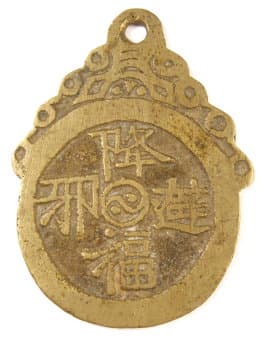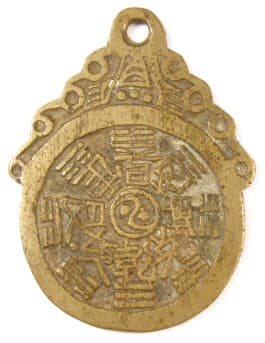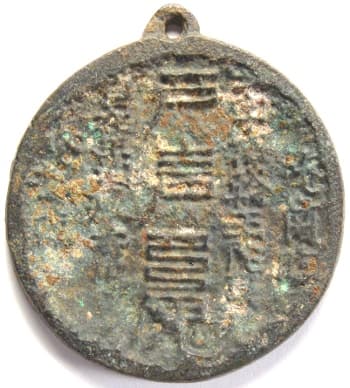
Daoist (Taoist) Charms

Introduction and History of Daoist Charms
The ancient Chinese believed
that good fortune and misfortune were the result of spirit
intervention. Evidence from the Zhou (Chou) Dynasty
(11th Century - 221 BCE) indicates that the Chinese dealt with
evil spirits in the same way they dealt 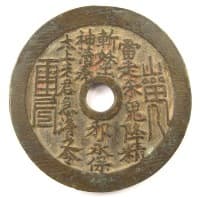 with their
human enemies. Several times a year and during solemn
occasions, swarms of exorcists would run through the streets
shouting and thrusting their spears in the air to expel the
evil spirits. Additionally, human prisoners were
dismembered outside the city gates as a signal as to what
would be the fate of any evil spirit that dared enter the
city.
with their
human enemies. Several times a year and during solemn
occasions, swarms of exorcists would run through the streets
shouting and thrusting their spears in the air to expel the
evil spirits. Additionally, human prisoners were
dismembered outside the city gates as a signal as to what
would be the fate of any evil spirit that dared enter the
city.
Since ancient times, the Chinese have believed that Chinese characters have a magical power to influence spirits. According to the "Book of Master Huainan" (淮南子), when Cang Jie (仓颉) invented Chinese characters during the reign (circa 2698 - 2598 BCE) of the legendary Yellow Emperor (Huangdi 黃帝), "millet fell from the sky and the spirits cried at night". This was because the spirits were afraid of being controlled by the magic power of Chinese characters used for amulets and charms.
It seems to be almost universal that the art of writing evokes a magical power in populations which are mainly illiterate.
At least from the time of the Han Dynasty (206 BCE - 220 AD), people wore charms or amulets on their waist or around their necks for protection (see pendant charms). These talismans often carried an inscription requesting a Daoist deified person, such as the "God of Thunder" or Lao Zi (also known as Lao Tzu and considered the author of the classic Taoist text Dao De Jing (Tao Te Ching 道德经)), to "expel" evil influences and "kill" demons, and also to "send down" good fortune and happiness.
Because these inscriptions frequently requested the God of Thunder (Lei Gong 雷 公 or Lei Shen 雷 神) to use thunderbolts (ting 霆) to kill the bogies or evil spirits, these amulets are often referred to as "Lei Ting" (雷霆) charms or "Lei Ting curse" charms.
Under the rule of Chinese emperors, official documents, including mandates and decrees, carried absolute authority. Such influence further fostered the belief by the common people in the power of Chinese characters. The Daoists were able to transfer to the spiritual world this concept of absolute power over people and the magical power of the written language.
Thus, the inscriptions on amulets and charms resembled official imperial documents of the time. The amulet would request that a "command" be issued from a "high official" to the "evil" spirits or bogies. The command needed to come from a deified "high official" with the prestige and power necessary to enforce the order. Frequently, this spirit was the God of Thunder with his arsenal of thunderbolts. Sometimes Lao Zi (Lao-Tzu 老子), the founder of Daoism (Taoism), would be asked to intercede.
The amulet inscriptions would request that the evil spirits be expelled or killed.
The inscription or legend would usually conclude in the same manner as an official government order with words such as "respect this command" or "quickly, quickly, this is an order". A couple of the charm inscriptions displayed below conclude with the expression "let it (the command) be executed as fast as Lu Ling." Lu Ling was a famous runner in ancient China.
(For additional information on Daoism, including material on Hundun (the Cosmic Gourd) and Li Tie Guai (one of the Eight Daoist Immortals), please see gourd charms.)
"Magic writing" symbols are usually placed at the beginning
and end of the inscriptions.
Several of the Daoist charms below display "magic writing" characters and translation is provided when known.
*** Please also see an interesting daoist talisman discussed in great detail at Daoist Talisman and the Five Great Mountains.
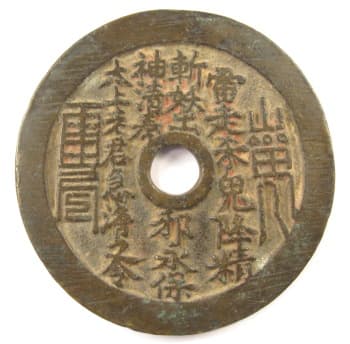 This is a very large and nicely cast
specimen of an old Daoist charm. The central hole is
round as opposed to square.
This is a very large and nicely cast
specimen of an old Daoist charm. The central hole is
round as opposed to square.
The large characters at the extreme right and extreme left are not Chinese but rather Daoist "magic writing". While Daoist priests would like for the meaning to be kept a secret, these particular magic writing characters can now be understood.
Regarding the very large character on the left, the upper half is "magic writing" for the Chinese character lei (雷) which means "thunder" and refers to the "God of Thunder". The lower part is "magic writing" for the Chinese character ling (令) which means "to order".
The top portion of the very large character on the right, consisting of what looks like a three prong fork with three small circles underneath, is the magic writing equivalent to sha (杀) which means "to kill". The part of the character below the three small circles is the Chinese character gui (鬼) which means "ghost" or "spirit".
The inscription of the two magic writing characters, read left to right, can thus be translated as the "God of Thunder orders the demons to be killed".
Each line of the Chinese inscription on the charm is written vertically top to bottom and right to left. For your convenience, the inscription is written below in the more conventional method with each line read from left to right:
雷走杀鬼降精 (lei zou sha gui jiang jing)
斩妖出邪永保 (zhan yao chu xie yong bao)
神情 奉 (shen qing feng)
太上老君急汲之令 (tai shang lao jun ji ji zhi ling)
The Chinese character inscription can be translated as follows:
"God of Thunder (Lei) clear out and kill the ghosts and send down purity.
Behead the demons, expel the evil and keep us eternally safe.
Let this command from Lao Zi (Tai Shang Lao Jun1)
Be executed quickly."
1 The title Tai Shang Lao Jun (太 上老君) was bestowed upon Lao Zi (老子) by imperial command in 1013 AD.
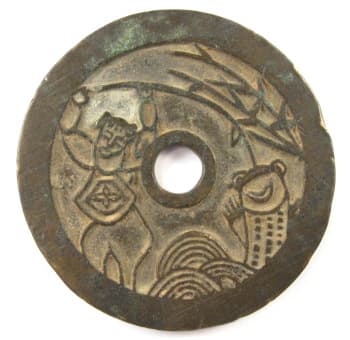 The reverse side of the
charm is intriguing. It appears to portray Liu Hai and
the Three-Legged Toad. Research seems to confirm that
this indeed is the theme being depicted. (Please visit
my Liu Hai page dedicated to these
charms if you have an interest.)
The reverse side of the
charm is intriguing. It appears to portray Liu Hai and
the Three-Legged Toad. Research seems to confirm that
this indeed is the theme being depicted. (Please visit
my Liu Hai page dedicated to these
charms if you have an interest.)
I still have some doubts, however.
The person looks like a young woman to me and Liu Hai is a male. Also, all the other Liu Hai charms that I have seen always show the toad as having three legs and the picture here only shows the upper torso.
Additionally, the Liu Hai story usually associates Liu Hai using gold coins on a string to catch the toad in a well. In the scene here, there are no coins shown and the waves and bamboo would seem to indicate it is a river or stream.
However, until I can find an alternative explanation, I will follow the consensus and present the charm as Liu Hai and the Three-Legged Toad also known as "Liu Hai playing with the Golden Toad" .
This charm is 61 mm in diameter and 3.8 mm in thickness.
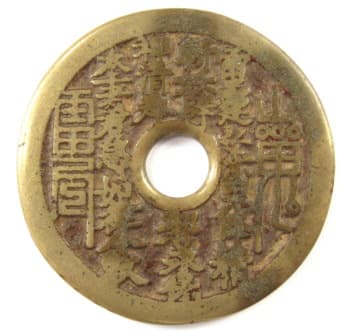
The obverse side of this Daoist charm is almost identical to that of the charm above.
The differences in the wording of the Chinese inscription are as follows:
雷霆"杀 鬼 降精 (The name of the God of Thunder and the word thunderbolt is repeated using ditto mark ("))
斩妖辟邪永保 (Substitutes bi (辟), meaning to "keep away" for chu (出) meaning "to expel"))
太上老君急"如律令敕 (Repeats 急 with " ditto mark, adds ru (如) meaning "like", and adds chi 敕 meaning "imperial order or edict")
The Chinese character inscription can be translated as follows:
"God of Thunder (Lei) thunderbolts, God of Thunder thunderbolts, kill the ghosts and send down purity.
Behead the demons, expel the evil and keep us eternally safe.
Receive this edict from Lao Zi (Tai Shang Lao Jun) and
Let it be executed as fast as Lu Ling.2"
2 Lu Ling was a famous runner from ancient times. He purportedly lived during the time of King Mu who became renowned for his chariot and eight outstanding horses. Please see Ancient Chinese Horse Coins for more information.
 with their
human enemies. Several times a year and during solemn
occasions, swarms of exorcists would run through the streets
shouting and thrusting their spears in the air to expel the
evil spirits. Additionally, human prisoners were
dismembered outside the city gates as a signal as to what
would be the fate of any evil spirit that dared enter the
city.
with their
human enemies. Several times a year and during solemn
occasions, swarms of exorcists would run through the streets
shouting and thrusting their spears in the air to expel the
evil spirits. Additionally, human prisoners were
dismembered outside the city gates as a signal as to what
would be the fate of any evil spirit that dared enter the
city.Since ancient times, the Chinese have believed that Chinese characters have a magical power to influence spirits. According to the "Book of Master Huainan" (淮南子), when Cang Jie (仓颉) invented Chinese characters during the reign (circa 2698 - 2598 BCE) of the legendary Yellow Emperor (Huangdi 黃帝), "millet fell from the sky and the spirits cried at night". This was because the spirits were afraid of being controlled by the magic power of Chinese characters used for amulets and charms.
It seems to be almost universal that the art of writing evokes a magical power in populations which are mainly illiterate.
At least from the time of the Han Dynasty (206 BCE - 220 AD), people wore charms or amulets on their waist or around their necks for protection (see pendant charms). These talismans often carried an inscription requesting a Daoist deified person, such as the "God of Thunder" or Lao Zi (also known as Lao Tzu and considered the author of the classic Taoist text Dao De Jing (Tao Te Ching 道德经)), to "expel" evil influences and "kill" demons, and also to "send down" good fortune and happiness.
Because these inscriptions frequently requested the God of Thunder (Lei Gong 雷 公 or Lei Shen 雷 神) to use thunderbolts (ting 霆) to kill the bogies or evil spirits, these amulets are often referred to as "Lei Ting" (雷霆) charms or "Lei Ting curse" charms.
Under the rule of Chinese emperors, official documents, including mandates and decrees, carried absolute authority. Such influence further fostered the belief by the common people in the power of Chinese characters. The Daoists were able to transfer to the spiritual world this concept of absolute power over people and the magical power of the written language.
Thus, the inscriptions on amulets and charms resembled official imperial documents of the time. The amulet would request that a "command" be issued from a "high official" to the "evil" spirits or bogies. The command needed to come from a deified "high official" with the prestige and power necessary to enforce the order. Frequently, this spirit was the God of Thunder with his arsenal of thunderbolts. Sometimes Lao Zi (Lao-Tzu 老子), the founder of Daoism (Taoism), would be asked to intercede.
The amulet inscriptions would request that the evil spirits be expelled or killed.
The inscription or legend would usually conclude in the same manner as an official government order with words such as "respect this command" or "quickly, quickly, this is an order". A couple of the charm inscriptions displayed below conclude with the expression "let it (the command) be executed as fast as Lu Ling." Lu Ling was a famous runner in ancient China.
(For additional information on Daoism, including material on Hundun (the Cosmic Gourd) and Li Tie Guai (one of the Eight Daoist Immortals), please see gourd charms.)
Daoist Magic Writing
Daoist magic writing (fuwen 符文) is also
known as Daoist magic script characters, Daoist magic
figures, Daoist magic formulas, Daoist secret talismanic
writing, and talismanic characters. These are
symbols with twisted strokes that sometimes resemble
Chinese characters. Only Daoist priests can read and
understand this magic writing and the characters can
differ from sect to sect. Their method of writing is
passed down secretly from master to disciple.
If magic writing were easy to understand then anyone could have the power to control the spirits.
The origin of "magic writing", according to such ancient Chinese texts as the "Records of the Divine Talismans of the Three Grottoes" (三洞神符纪), is from the condensation of clouds in the sky.
Some magic script characters appear to have been formed by stacking one Chinese character atop another and making them into a single character. This technique of linking or combining characters was used not only by the Taoists, however, since it also appears on other types of Chinese charms and woodblock prints.
If magic writing were easy to understand then anyone could have the power to control the spirits.
The origin of "magic writing", according to such ancient Chinese texts as the "Records of the Divine Talismans of the Three Grottoes" (三洞神符纪), is from the condensation of clouds in the sky.
Some magic script characters appear to have been formed by stacking one Chinese character atop another and making them into a single character. This technique of linking or combining characters was used not only by the Taoists, however, since it also appears on other types of Chinese charms and woodblock prints.
Several of the Daoist charms below display "magic writing" characters and translation is provided when known.
*** Please also see an interesting daoist talisman discussed in great detail at Daoist Talisman and the Five Great Mountains.
Examples of Daoist Charms
 This is a very large and nicely cast
specimen of an old Daoist charm. The central hole is
round as opposed to square.
This is a very large and nicely cast
specimen of an old Daoist charm. The central hole is
round as opposed to square.The large characters at the extreme right and extreme left are not Chinese but rather Daoist "magic writing". While Daoist priests would like for the meaning to be kept a secret, these particular magic writing characters can now be understood.
Regarding the very large character on the left, the upper half is "magic writing" for the Chinese character lei (雷) which means "thunder" and refers to the "God of Thunder". The lower part is "magic writing" for the Chinese character ling (令) which means "to order".
The top portion of the very large character on the right, consisting of what looks like a three prong fork with three small circles underneath, is the magic writing equivalent to sha (杀) which means "to kill". The part of the character below the three small circles is the Chinese character gui (鬼) which means "ghost" or "spirit".
The inscription of the two magic writing characters, read left to right, can thus be translated as the "God of Thunder orders the demons to be killed".
Each line of the Chinese inscription on the charm is written vertically top to bottom and right to left. For your convenience, the inscription is written below in the more conventional method with each line read from left to right:
雷走杀鬼降精 (lei zou sha gui jiang jing)
斩妖出邪永保 (zhan yao chu xie yong bao)
神情 奉 (shen qing feng)
太上老君急汲之令 (tai shang lao jun ji ji zhi ling)
The Chinese character inscription can be translated as follows:
"God of Thunder (Lei) clear out and kill the ghosts and send down purity.
Behead the demons, expel the evil and keep us eternally safe.
Let this command from Lao Zi (Tai Shang Lao Jun1)
Be executed quickly."
1 The title Tai Shang Lao Jun (太 上老君) was bestowed upon Lao Zi (老子) by imperial command in 1013 AD.
 The reverse side of the
charm is intriguing. It appears to portray Liu Hai and
the Three-Legged Toad. Research seems to confirm that
this indeed is the theme being depicted. (Please visit
my Liu Hai page dedicated to these
charms if you have an interest.)
The reverse side of the
charm is intriguing. It appears to portray Liu Hai and
the Three-Legged Toad. Research seems to confirm that
this indeed is the theme being depicted. (Please visit
my Liu Hai page dedicated to these
charms if you have an interest.)I still have some doubts, however.
The person looks like a young woman to me and Liu Hai is a male. Also, all the other Liu Hai charms that I have seen always show the toad as having three legs and the picture here only shows the upper torso.
Additionally, the Liu Hai story usually associates Liu Hai using gold coins on a string to catch the toad in a well. In the scene here, there are no coins shown and the waves and bamboo would seem to indicate it is a river or stream.
However, until I can find an alternative explanation, I will follow the consensus and present the charm as Liu Hai and the Three-Legged Toad also known as "Liu Hai playing with the Golden Toad" .
This charm is 61 mm in diameter and 3.8 mm in thickness.

The obverse side of this Daoist charm is almost identical to that of the charm above.
The differences in the wording of the Chinese inscription are as follows:
雷霆"杀 鬼 降精 (The name of the God of Thunder and the word thunderbolt is repeated using ditto mark ("))
斩妖辟邪永保 (Substitutes bi (辟), meaning to "keep away" for chu (出) meaning "to expel"))
太上老君急"如律令敕 (Repeats 急 with " ditto mark, adds ru (如) meaning "like", and adds chi 敕 meaning "imperial order or edict")
The Chinese character inscription can be translated as follows:
"God of Thunder (Lei) thunderbolts, God of Thunder thunderbolts, kill the ghosts and send down purity.
Behead the demons, expel the evil and keep us eternally safe.
Receive this edict from Lao Zi (Tai Shang Lao Jun) and
Let it be executed as fast as Lu Ling.2"
2 Lu Ling was a famous runner from ancient times. He purportedly lived during the time of King Mu who became renowned for his chariot and eight outstanding horses. Please see Ancient Chinese Horse Coins for more information.
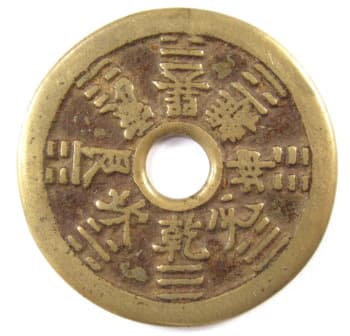
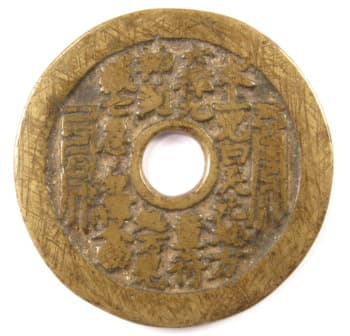
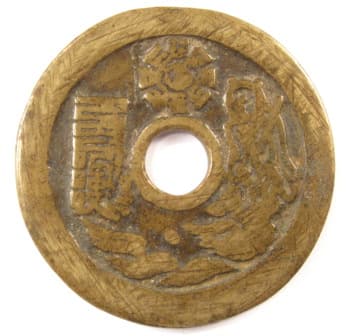 This is the reverse side of the amulet. On
the left side is Daoist "magic writing". Its meaning is
unclear.
This is the reverse side of the amulet. On
the left side is Daoist "magic writing". Its meaning is
unclear.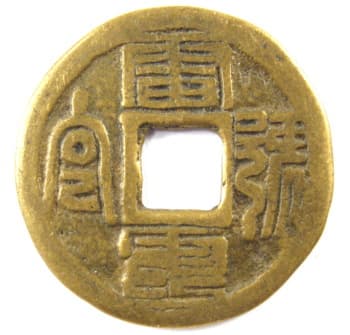
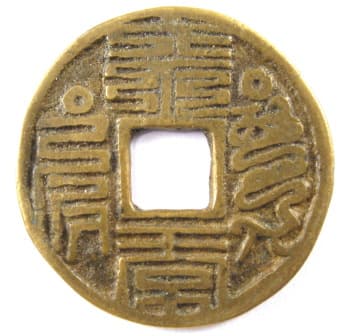
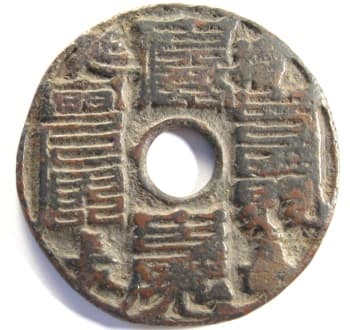
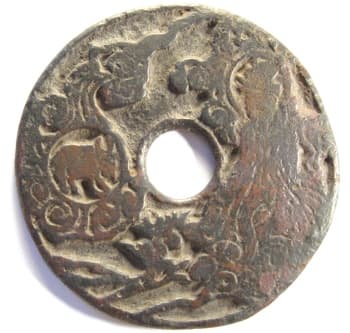
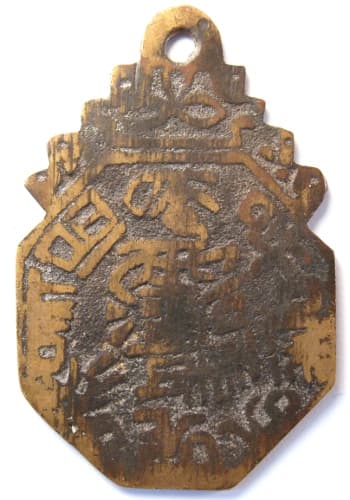 This pendant charm is
unique in that it represents a syncretism of the major Chinese
religions of Daoism and Buddhism.
This pendant charm is
unique in that it represents a syncretism of the major Chinese
religions of Daoism and Buddhism.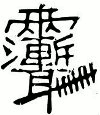

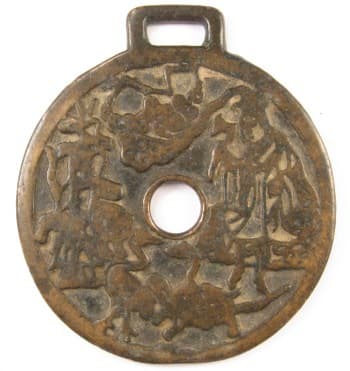 While
this old charm has no inscription, it nevertheless tells an
important story in Taoist history.
While
this old charm has no inscription, it nevertheless tells an
important story in Taoist history.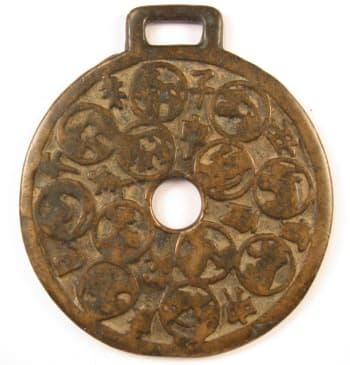
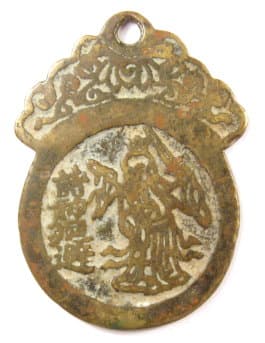
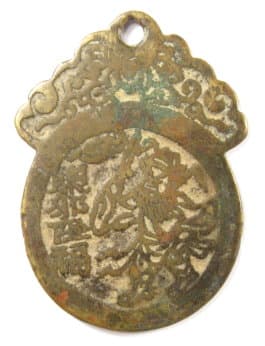 The
reverse side expresses a wish for good fortune and
happiness. The Taoist Immortal is Zhong Kui (钟馗) with a
sword in his right hand. He is famous as a fearsome slayer
of evil demons. The projections from each side of his hat
are "demon-seeking" devices that can point to unseen and lurking
dangers.
The
reverse side expresses a wish for good fortune and
happiness. The Taoist Immortal is Zhong Kui (钟馗) with a
sword in his right hand. He is famous as a fearsome slayer
of evil demons. The projections from each side of his hat
are "demon-seeking" devices that can point to unseen and lurking
dangers.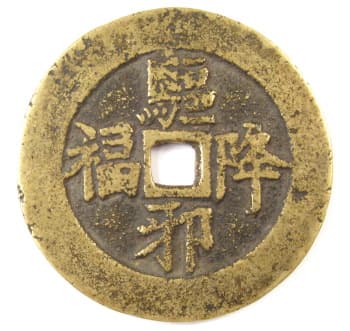
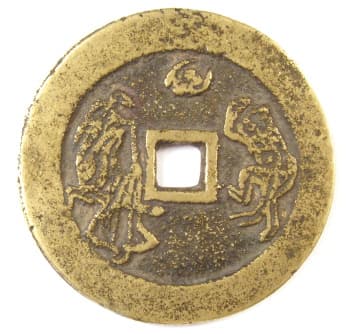
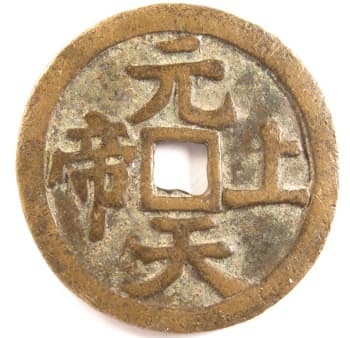 According to tradition, Laozi's real name was Li
Er (李耳). The emperors of the Tang Dynasty had the
same surname Li (李) and consequently
traced their lineage back to Laozi.
According to tradition, Laozi's real name was Li
Er (李耳). The emperors of the Tang Dynasty had the
same surname Li (李) and consequently
traced their lineage back to Laozi.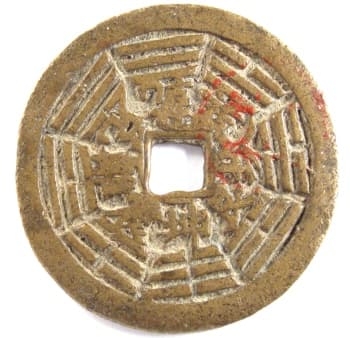
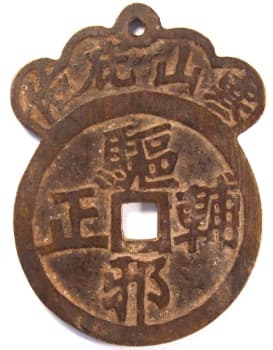
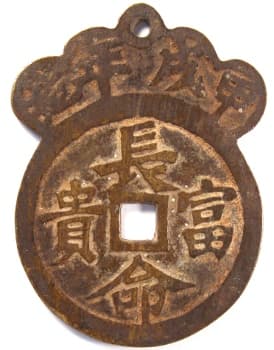 The inscription at the top
of the reverse side of the charm is
The inscription at the top
of the reverse side of the charm is 